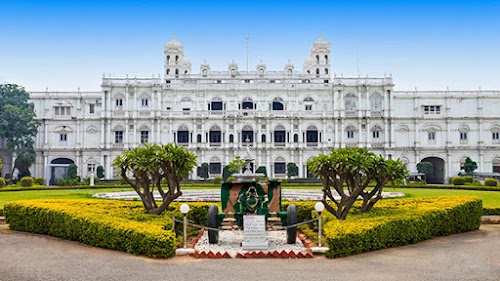
Discover Incredible Places in Gwalior
Explore our handpicked collection of breathtaking destinations across India
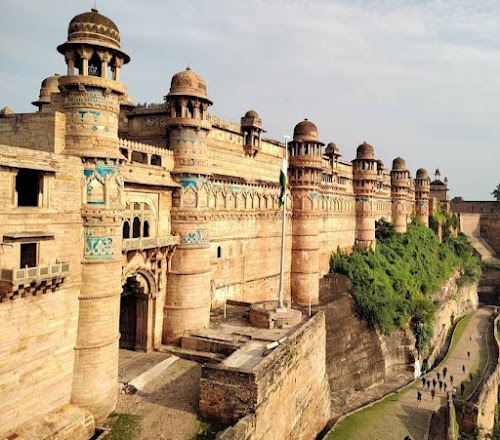
Gwalior Fort
Gwalior Fort, a majestic hilltop fort, dominates the Gwalior skyline and offers breathtaking panoramic views of the city. This imposing structure is a testament to the region's rich history and architectural prowess. The fort's intricate carvings, stunning palaces, and ancient temples provide a fascinating glimpse into the lives of the rulers who once resided within its walls. Explore the Man Singh Palace with its vibrant tile work, the Gujari Mahal, now a museum, and the Teli Ka Mandir, a unique architectural marvel. The fort is a must-visit destination for history buffs, architecture enthusiasts, and anyone seeking a captivating cultural experience. Don't miss the light and sound show in the evening for an immersive journey through the fort's history.
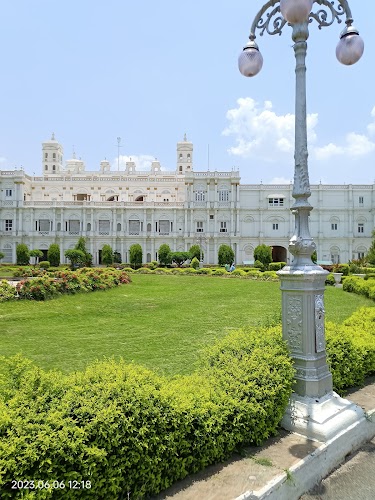
Jai Vilas Palace
Jai Vilas Palace, a magnificent testament to the Scindia dynasty's opulence, stands as a major tourist attraction in Gwalior. A portion of the palace serves as a museum, showcasing the rich history and cultural heritage of the Scindias. Visitors can marvel at the Durbar Hall, adorned with massive chandeliers, explore the royal collection of vintage cars, and witness the grandeur of the dining hall laid out for a royal banquet. The palace architecture blends Italian, Tuscan, and Corinthian styles, offering a unique visual experience. The palace also houses a library with a vast collection of books and manuscripts. The palace's sheer size and lavish interiors are breathtaking, offering a glimpse into the lives of the erstwhile rulers.

Gurudwara Data Bandi Chhorh Sahib
Gurudwara Data Bandi Chhorh Sahib is a significant Sikh shrine in Gwalior, Madhya Pradesh, India. It commemorates the imprisonment of Guru Hargobind Sahib, the sixth Sikh Guru, by Mughal Emperor Jahangir and his subsequent release along with 52 other Hindu kings. The Gurudwara stands as a symbol of religious harmony and the Guru's compassion for those unjustly imprisoned. The architecture is a blend of Sikh and Mughal styles, featuring a large dome, intricate carvings, and a serene atmosphere. Visitors can experience the langar (community kitchen), a hallmark of Sikh hospitality, and participate in prayers and hymns. The Gurudwara offers a peaceful and spiritually enriching experience for people of all faiths.
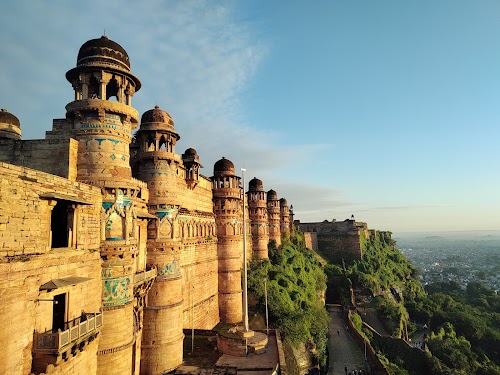
Man Mandir Palace
Man Mandir Palace, a jewel in Gwalior Fort, is a captivating testament to Rajput architecture. Built by Maharaja Man Singh Tomar in the 15th century, it's renowned for its intricate stone carvings, colourful tilework, and stunning panoramic views of Gwalior city. The palace's exterior boasts a frieze of vibrant blue, yellow, and green tiles depicting animals, adding a unique charm. Inside, explore the spacious courtyards, underground dungeons, and beautifully decorated rooms that once housed royal families. The palace complex is a must-see for history buffs, architecture enthusiasts, and anyone seeking to immerse themselves in the grandeur of India's past. Don't miss the Jauhar Kund, a poignant reminder of a historical event.

Teli Ka Mandir
Teli Ka Mandir, a unique architectural marvel, stands atop Gwalior Fort as the tallest structure within its walls. Unlike typical Hindu temples, it showcases a distinctive blend of architectural styles. Its Dravidian-style barrel-vaulted roof is a striking contrast to the Indo-Aryan features of other structures in the fort. Dedicated to Lord Vishnu, this 8th-century temple captivates visitors with its intricate carvings, imposing gateway, and the sheer scale of its construction. The temple offers panoramic views of the surrounding city, making it a must-visit destination for history buffs, architecture enthusiasts, and spiritual seekers alike. Its weathered facade whispers tales of centuries past, inviting you to delve into the rich heritage of Gwalior.

Sun Temple
The Sun Temple in Gwalior is a stunning architectural marvel, dedicated to the Sun God. Inspired by the famous Konark Sun Temple, it showcases intricate carvings and a vibrant red sandstone exterior. The temple's design features a chariot driven by seven horses, symbolizing the Sun God's journey across the sky. Visitors are captivated by the detailed sculptures depicting various deities, celestial beings, and scenes from Hindu mythology. The serene atmosphere and the temple's artistic grandeur make it a must-visit destination for those seeking spiritual solace and architectural appreciation. The surrounding gardens provide a peaceful setting for reflection and enjoyment of the temple's beauty.

National Chambal Ghariyal Wildlife Sanctuary
The National Chambal Ghariyal Wildlife Sanctuary, also known as the National Chambal Sanctuary, is a protected area along the Chambal River in North India. It was established in 1979 to conserve the critically endangered gharial, a species of crocodilian native to the Indian subcontinent. The sanctuary spans across three states: Madhya Pradesh, Rajasthan, and Uttar Pradesh, with a significant portion falling near Gwalior. Besides gharials, the sanctuary is home to a diverse range of flora and fauna, including the mugger crocodile, smooth-coated otter, various species of turtles, and numerous bird species. Visitors can explore the sanctuary through boat safaris and guided tours, offering excellent opportunities for wildlife viewing and photography. The serene environment and rich biodiversity make it a haven for nature enthusiasts and wildlife lovers.

Ekattarso Mahadev Mandir (Chausath Yogini Temple)
The Ekattarso Mahadev Mandir, also known as the Chausath Yogini Temple, is an ancient and fascinating monument located near Gwalior. This 9th-century temple is circular in design, featuring 64 small chambers, each originally housing a statue of a Yogini. At the center stands a shrine dedicated to Lord Shiva. The temple's unique architecture and historical significance make it a must-visit for history buffs and those interested in ancient Indian art and religious practices. The serene atmosphere and panoramic views from the hilltop location add to the temple's charm, offering a peaceful escape from the city's hustle and bustle. It's a great place for photography enthusiasts as well.
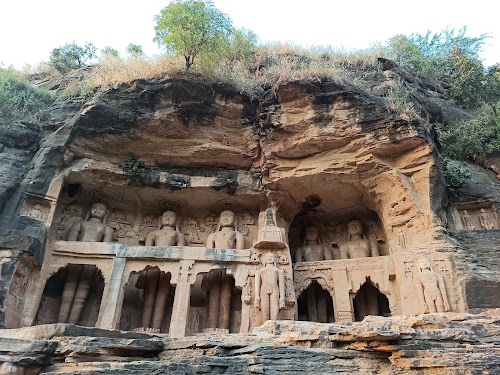
Gopachal Parvat
Gopachal Parvat, located in Gwalior, is a unique Jain heritage site renowned for its hundreds of rock-cut Jain sculptures carved into the hillside. These colossal statues, dating back to the 7th to 15th centuries, depict various Tirthankaras, the enlightened spiritual teachers of Jainism. The largest statue, a towering figure of Parshvanatha, stands at an impressive 47 feet. The intricate carvings and the sheer scale of the sculptures offer a captivating glimpse into the rich artistic and religious traditions of the region. The site offers panoramic views of Gwalior Fort and the surrounding city, making it a must-visit for history buffs, art enthusiasts, and those seeking spiritual solace.